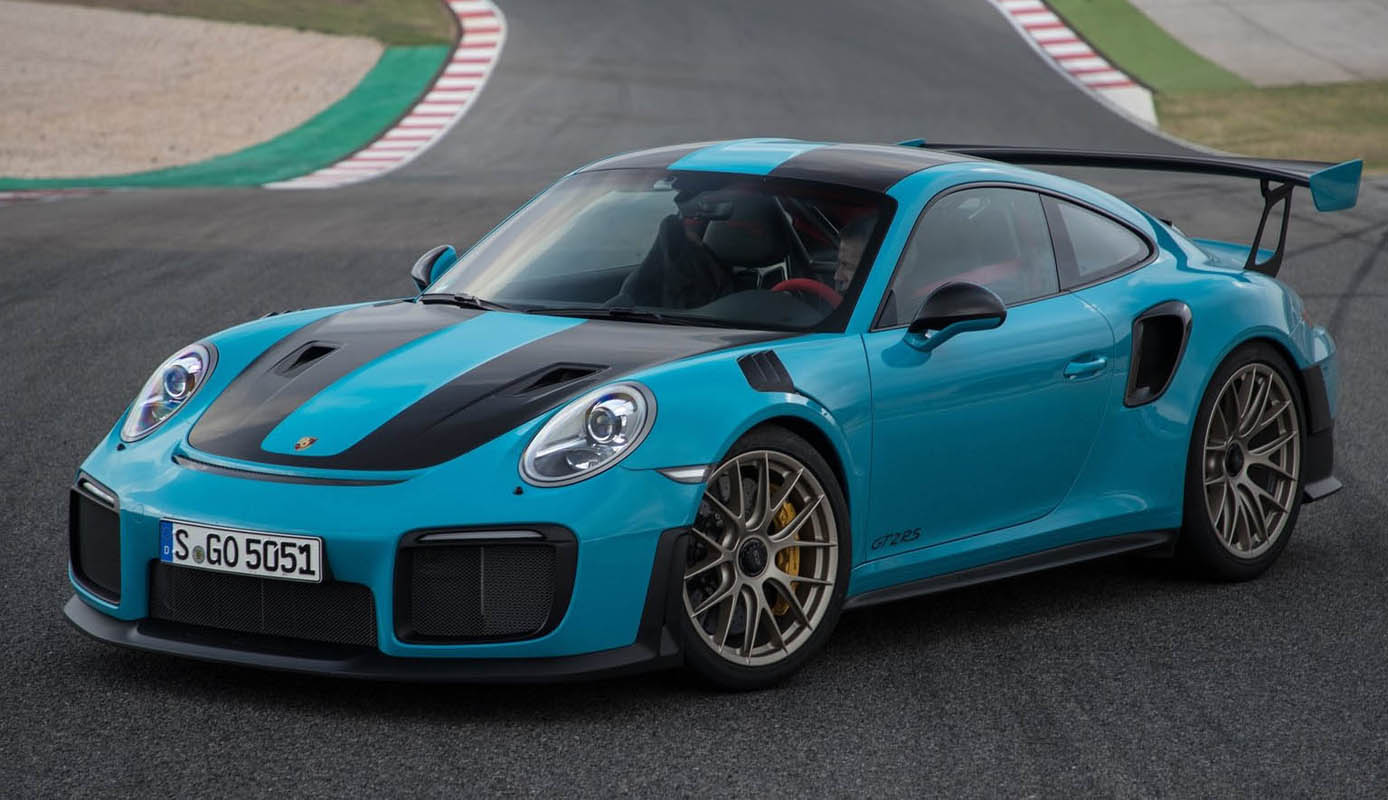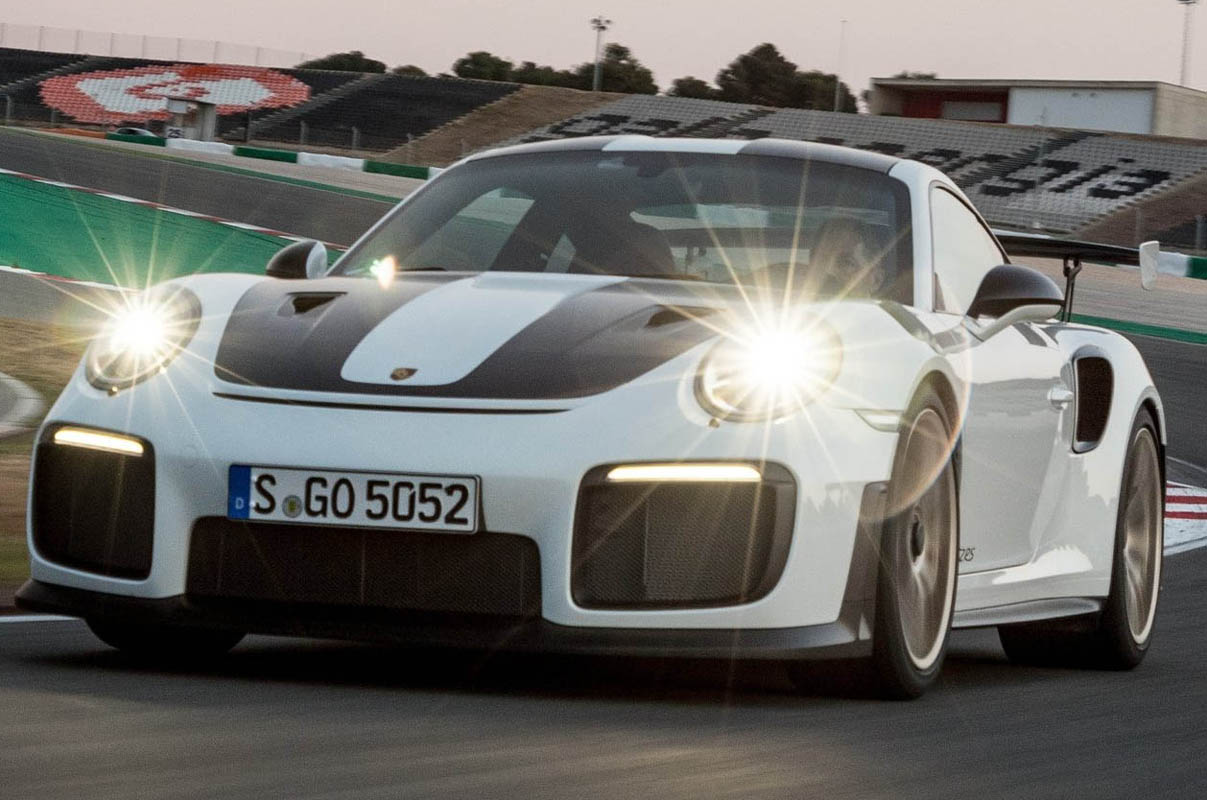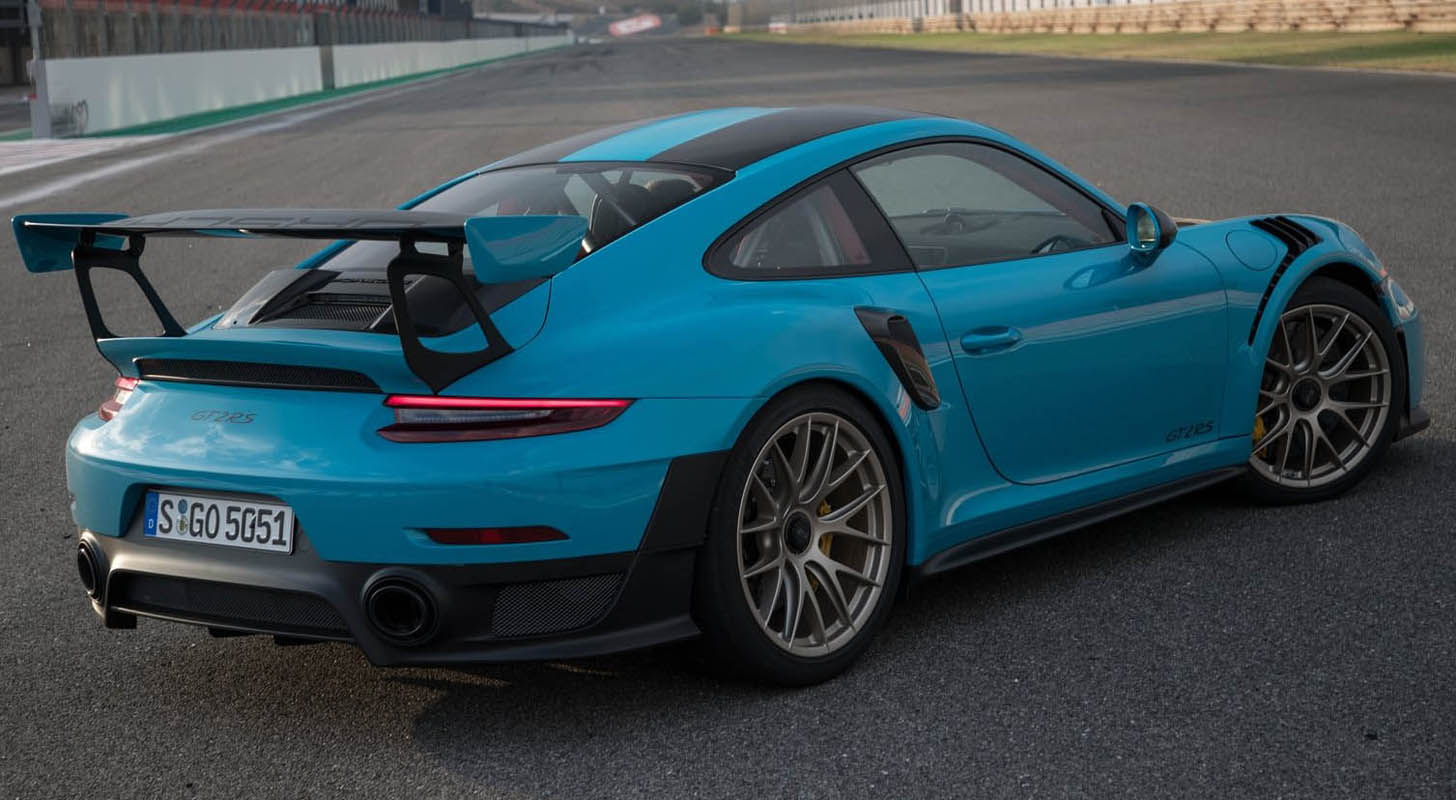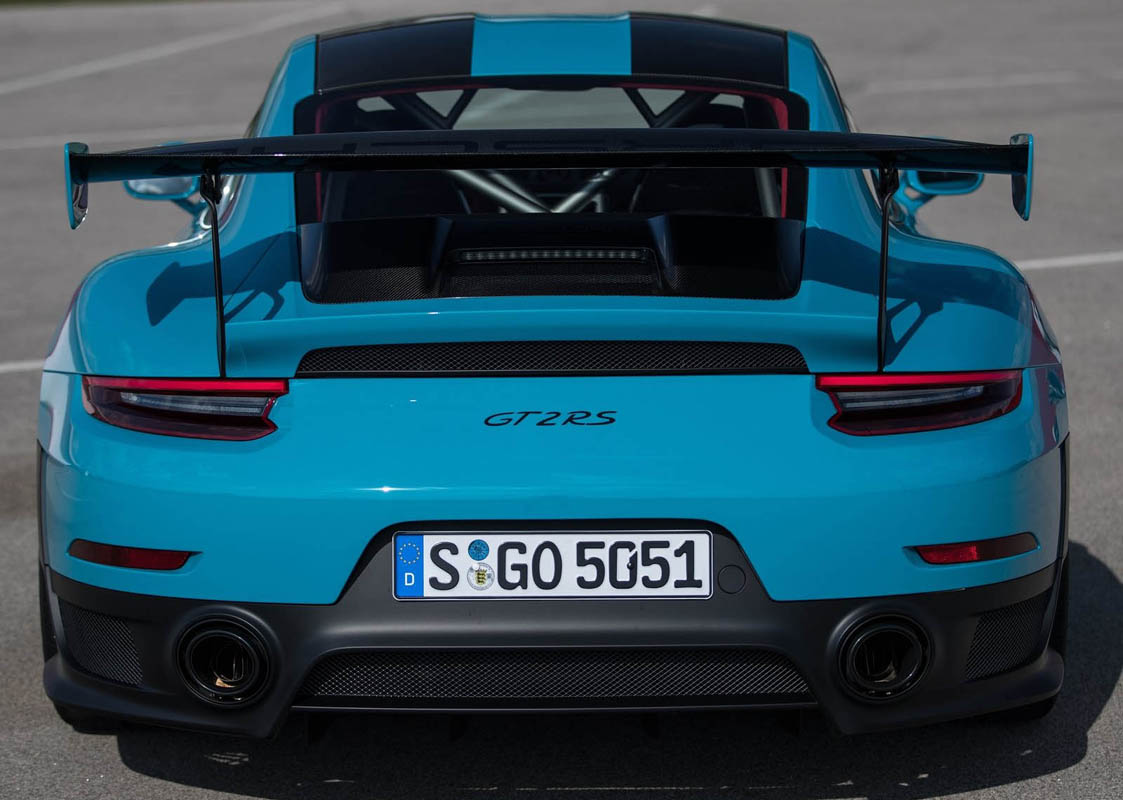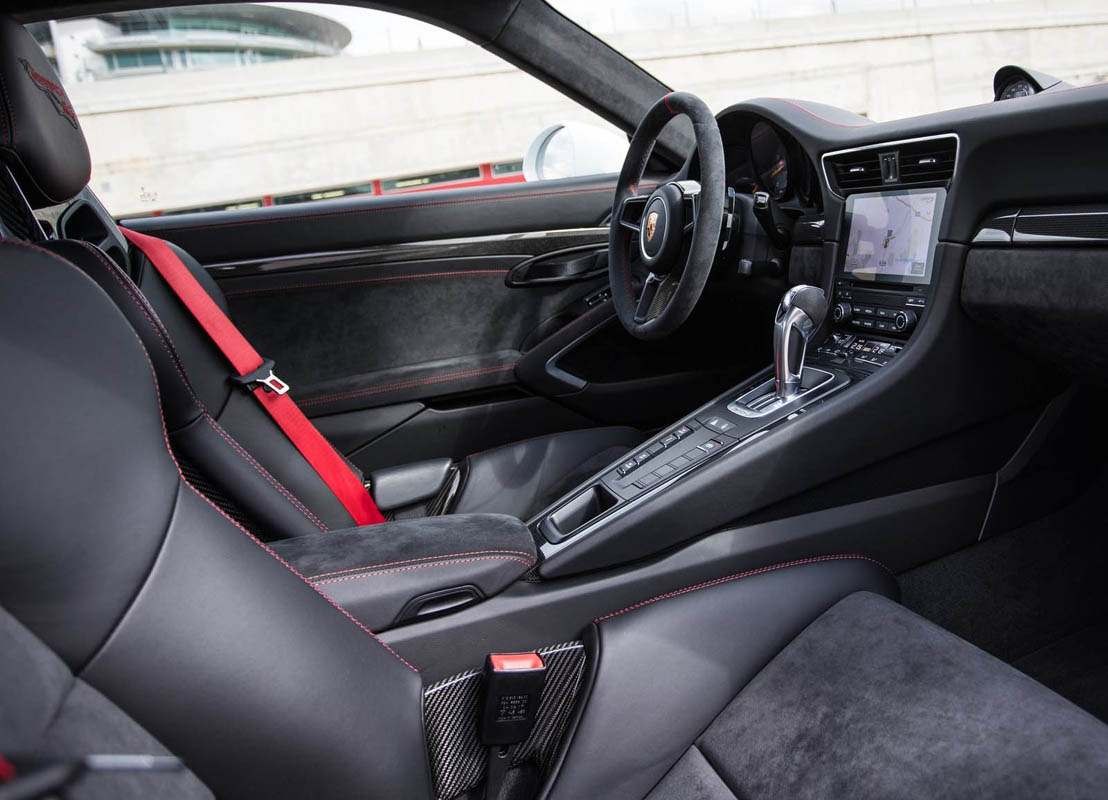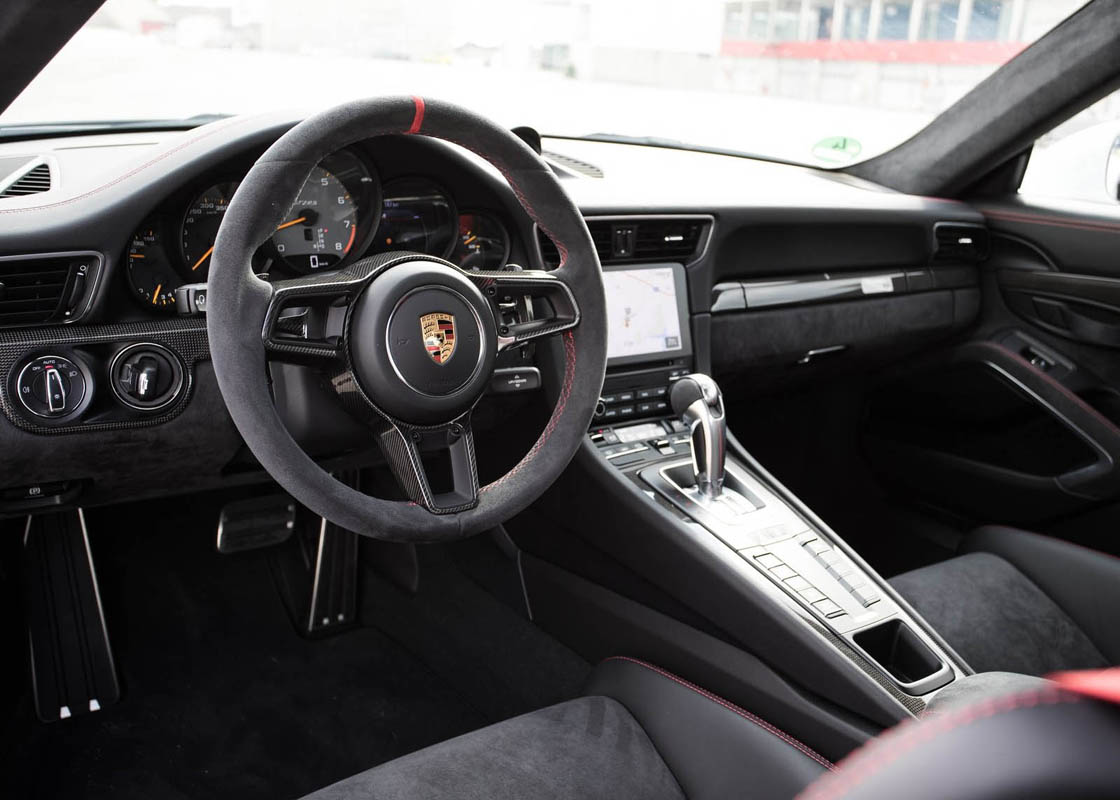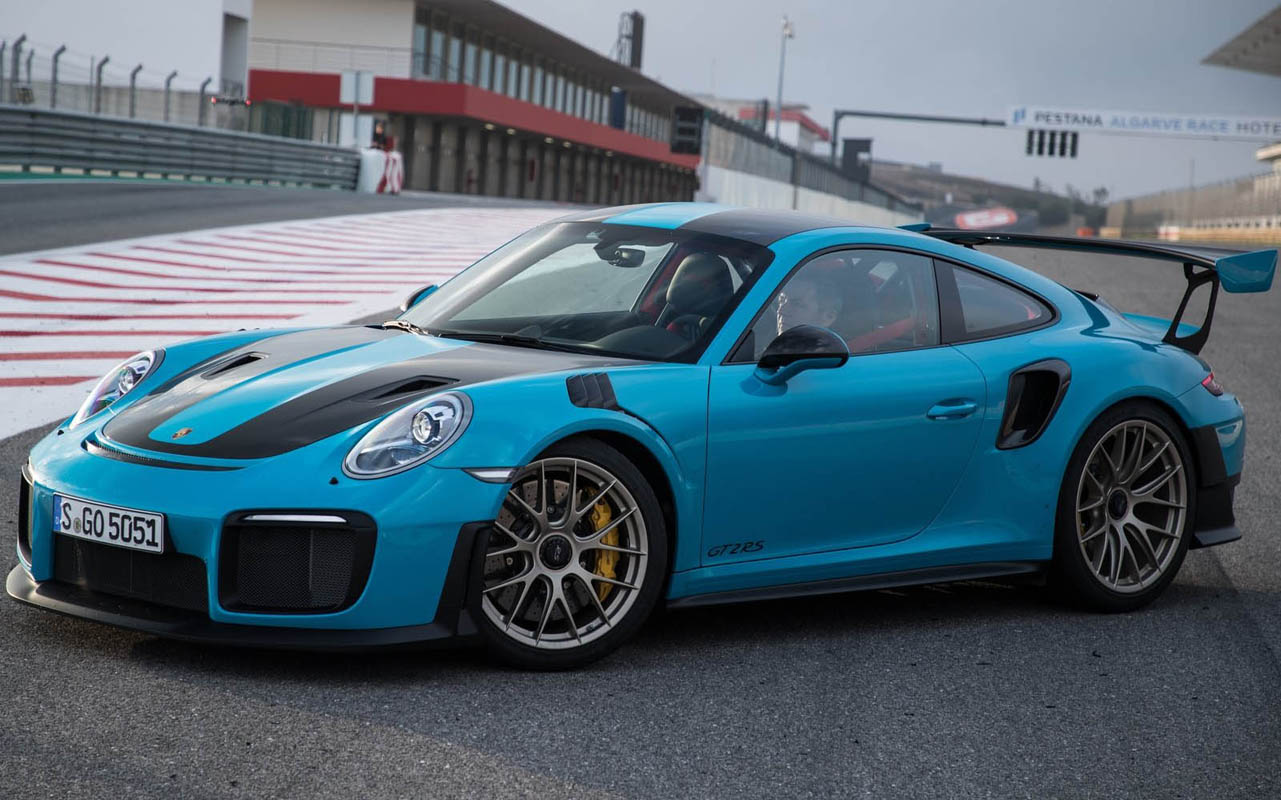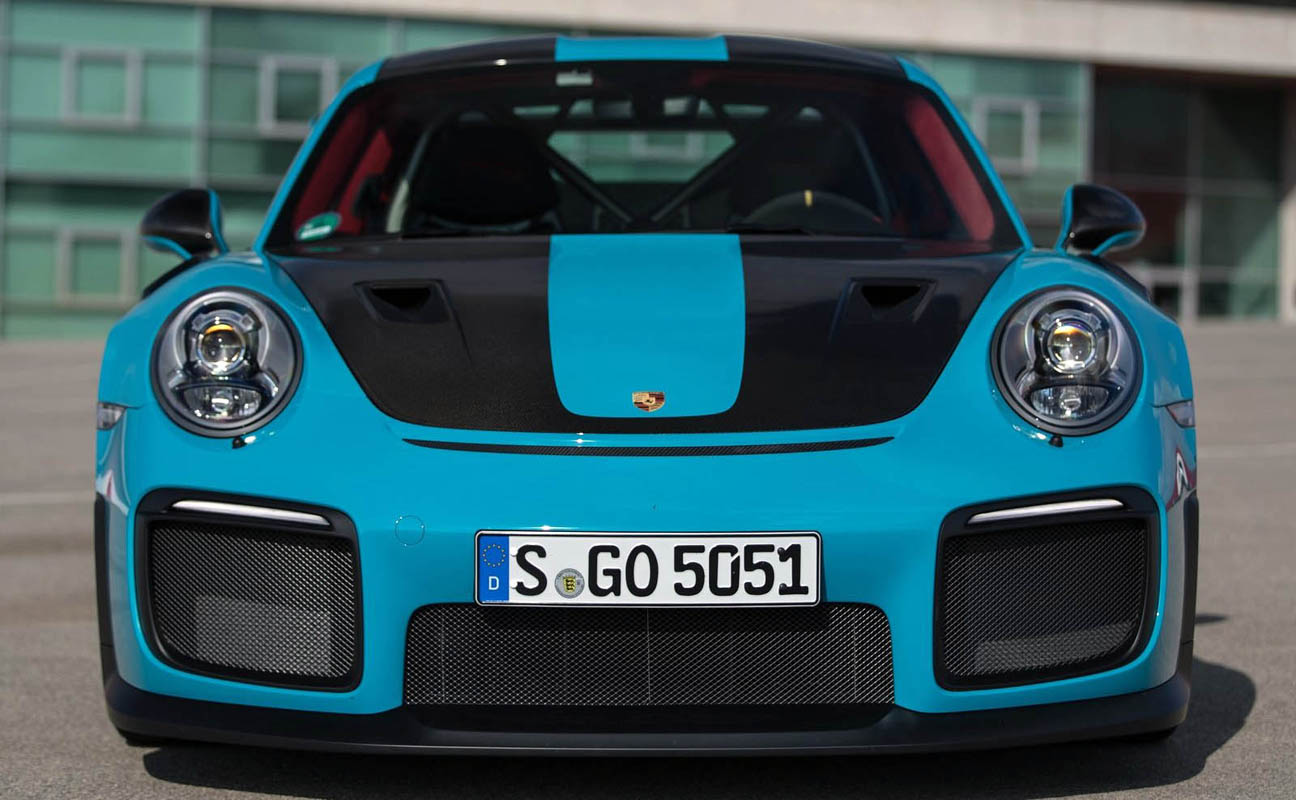
On a performance mission: With the new Porsche 911 GT2 RS, the Porsche motorsport department has developed the ultimate driving machine. The high-performance sports car is the fastest and most powerful 911 with approval for use on the road. On September 20, 2017, the vehicle achieved a record lap for road-approved sports cars on the Nürburgring Nordschleife, achieving the feat in 6 minutes and 47.3 seconds with Porsche test driver Lars Kern behind the wheel. The 515 kW (700 hp) delivered by the biturbo flat engine catapulted the two-seater vehicle – which weighs 1,470 kilograms – from zero to 100 km/h in 2.8 seconds. After 8.3 seconds, the speedometer clocked a speed of 200 km/h and continued moving up to a top speed of 340 km/h. Cornering speeds are also on a par with those achieved by super sports cars. The 911 GT2 RS reaches these speeds thanks to its flawless racing chassis and Ultra High Performance (UHP) tyres.
Discipline in sport means mastering every detail. Powerful air intakes and outlets and the imposing rear wing emphasise that the vehicle’s aerodynamics have mastered both form and design. Its large, wide wheels represent superior brake and lateral forces. The 265/35 ZR 20 (front) and 325/30 ZR 21 (rear) are the widest tyre dimensions that Porsche has fitted on a 911. Numerous elements made of carbon-fibre-reinforced plastic in a matt black carbon-weave finish are visible indications of the lightweight construction throughout.
Performance can always be increased – even for the Porsche 911 GT2 RS. That’s why the Porsche engineers have developed the Weissach package, which provides a weight saving of around 30 kg. The package includes additional elements made from carbon-fibre-reinforced plastic and titanium. For instance, the roof and the anti-roll bars are made of carbon, as are the coupling rods on both axles. Magnesium wheels reduce both the gross weight and the unsprung weight, providing a greater wealth of impressive chassis properties.
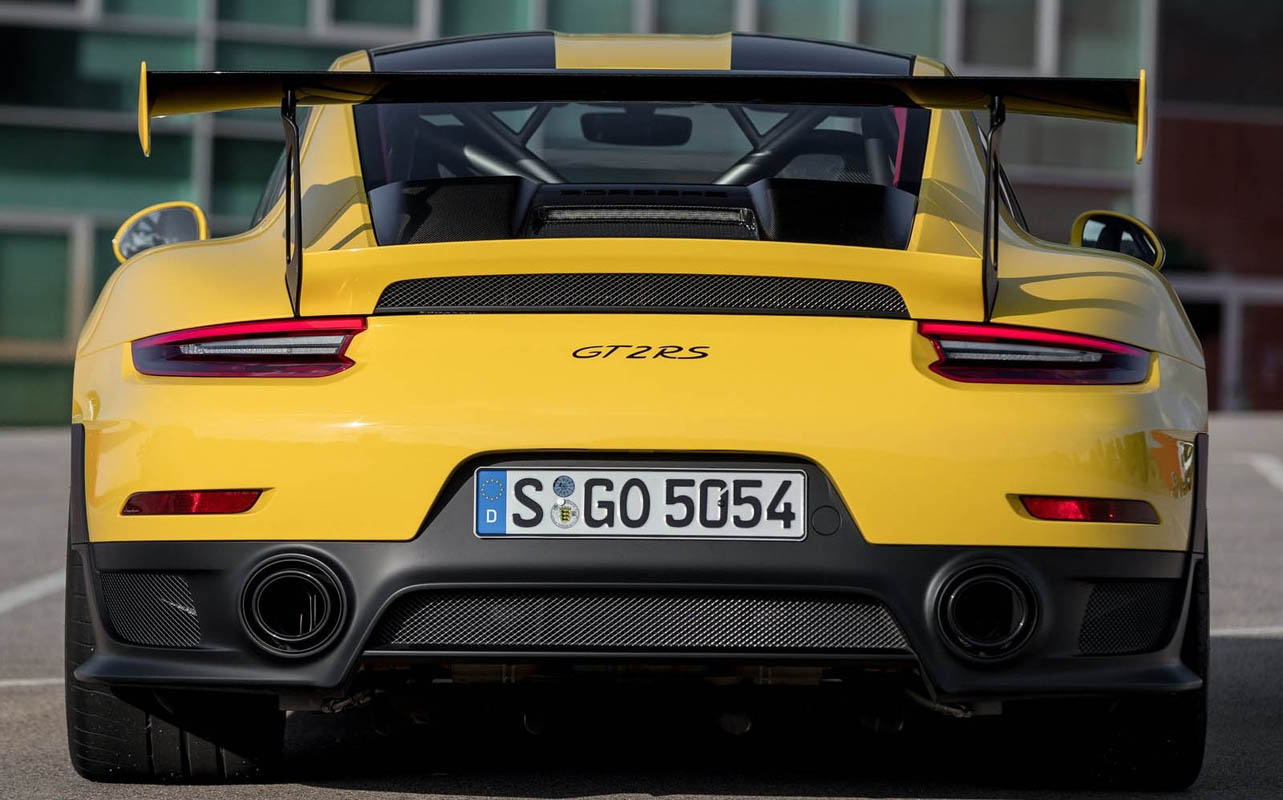
The 911 GT2 RS is the concentration of Porsche’s motorsport expertise into one high-performance sports car that also masters everyday driving. This means that despite its superior dynamics on the race track, this new top 911 model is as predictable and reliable to handle as any other Porsche sports car. The combined fuel consumption is 11.8 l/100 km.
The first 911 GT2 was developed in 1995 to meet homologation requirements for motorsport and was based on the 911 Turbo that was available at the time. The subsequent generations followed in 2000 and 2007. In 2010, Porsche designed the first Porsche 911 GT2 RS to be an even more powerful and near-motorsport variant. All 911 GT2 vehicles have several things in common: turbo engines with significantly increased power, motorsport chassis, high-performance brakes, and rear-wheel drive as opposed to all-wheel drive.
Full speed ahead: The most powerful Turbo for road use in the 911’s history
In the new 911 GT2 RS, the 3.8-litre engine from the 911 Turbo earns itself a place in the top flight of high-performance engines. As a reminder: The 3.8-litre flat engine, which made its debut back in 2009, precompresses its process air through two turbochargers with variable geometry (VTG turbochargers). Porsche was the first manufacturer to implement this technology in a petrol engine. The engineers at Porsche have now developed the original power rating of 368 kW (500 hp) into a staggering 515 kW (700 hp) – an increase of 40 per cent while retaining the same level of displacement. With this power at its disposal, the new Porsche 911 GT2 RS trumps its predecessor with a 3.6-litre engine by 59 kW (80 hp). The increase in displacement is also a factor that contributes to the enormous 750-Nm torque (an increase of 50 Nm).
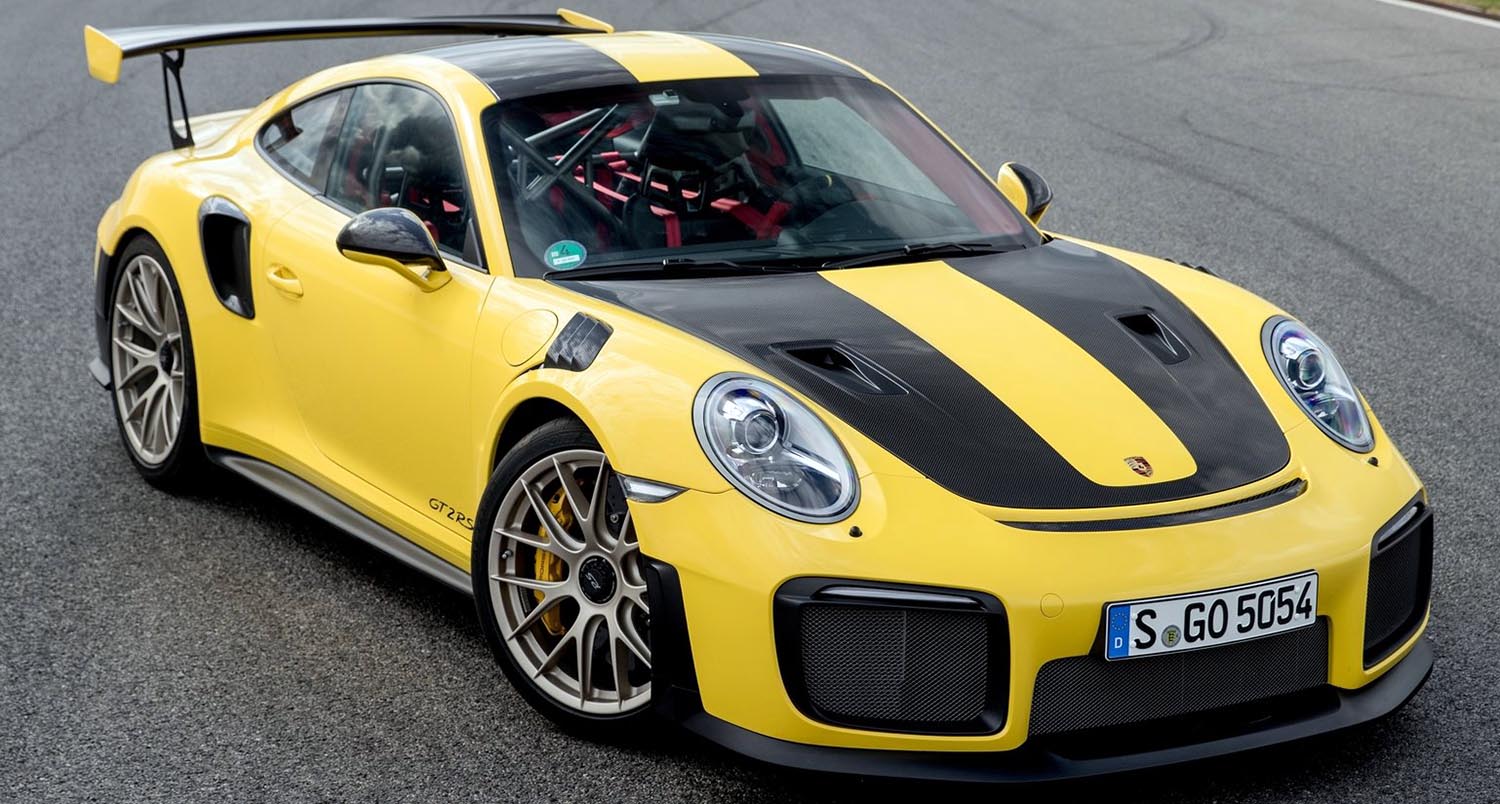
The high-performance engine builds on the engine fitted in the 911 Turbo S, which delivers 427 kW (580 hp) to the double-clutch transmission. The modifications include the traditional techniques for enhancing performance that are commonly used in the field of motorsport. However, the developers also implemented a number of innovative ideas. Bigger turbochargers force more process air into the combustion chambers, which in turn increases the energy conversion rate – particularly with the very short gas exchange cycles in the high-speed range. In parallel to this, specific pistons reduce the compression ratio by 0.5 units. The engine, which approximates that seen in the field of motorsport, is designed to achieve 7,200 crankshaft rotations a minute – something of a record among turbo engines.
Further down the air guide, an expansion intake system optimises the air flow. The functional principle of this expansion intake system is different to that of conventional intake systems: The distribution pipe is longer and smaller in diameter, while the intake manifolds themselves are shorter. As a result of this design, the air vibrations are different and the mixture in the combustion chamber is cooler. This, in turn, allows the mixture to be ignited to optimum effect in terms of performance.
Water for the air cooler: Innovative additional cooling of the charge air
Intermediate charge-air coolers reduce the temperature of the process air heated by the turbines through an innovative feature: A new water cooling system sprays the heat exchangers with liquid during load peaks. This lowers the gas temperature in the overpressure range by up to 20 degrees more than would be possible using the airstream alone. By delivering this reduction in temperature, the system ensures that the flow of charge air is thermally stable – even under extreme conditions. The water cooling system comes into action when, among other factors, the temperature of the process air in the intake manifold is above 50 degrees, the driver depresses the accelerator pedal by more than 90 per cent and the engine is running at a speed in excess of 3,000 rpm. The system is supplied by a five-litre tank filled with distilled water. With this system, the vehicle is able to achieve extremely fast lap times – such as on the Nürburgring Nordschleife – with maximum power output, even at high outside temperatures.

The burned gases pass from the two VTG turbochargers into the specially developed exhaust system made of extra-lightweight titanium. This system weighs approximately seven kilograms less than the one in the 911 Turbo. An automatically controlled flap system reduces the counter-pressure when load requirements are high, thereby increasing the power output and reducing fuel consumption.
The first 911 GT2 RS equipped with a double-clutch transmission
The Porsche Doppelkupplung (PDK) is an invention from the field of motorsport and has now found its way into the 911 GT2 RS. For the first time, the high-performance engine transmits its power via an automatically switching seven-speed gearbox on the rear axle, without interrupting traction. The PDK designed specifically with the GT in mind also offers special features that support the driver when using the vehicle on the race track. The Intelligent Shift Program (ISP) offered by the electronic transmission control system ensures faster and more spontaneous traction upshifts and extremely dynamic downshifts in overrun with sporty bursts on the throttle. In “PDK SPORT” mode, the downshifts during braking are even punchier, while the shifting points move to higher engine speeds during acceleration.
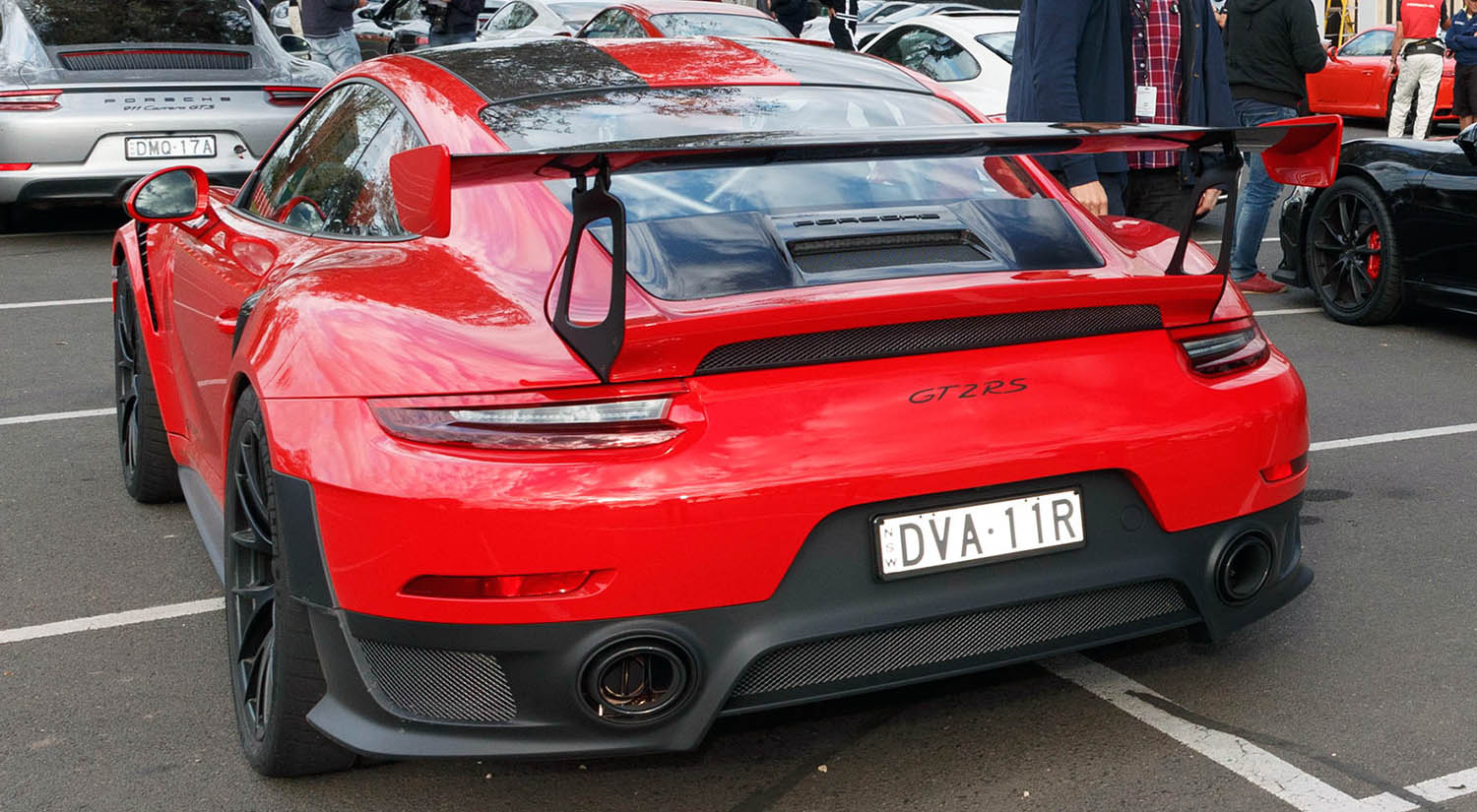
Designed specifically for use on the race track, the PDK also offers the special “Paddle Neutral” function, which Porsche reserves solely for its GT sports cars. If the driver pulls back on both gearshift paddles at the same time, the clutches of the PDK release, and the power delivery from the engine to the powertrain is interrupted. As soon as the driver lets go of both gearshift paddles, the clutch re-engages at lightning-fast speed if PSM is deactivated. If PSM is activated, the clutch re-engages quickly, but less spontaneously.
Using this function, the driver can bring an understeering vehicle back under control or conversely apply the propulsion force spontaneously to deliberately destabilise the rear of the vehicle. “Paddle Neutral” can also be used for acceleration from a standstill. As with a vehicle equipped with a manual transmission, the driver alone can determine the preferred acceleration characteristics using the clutch and gas pedal.
Motorsport chassis with active performance systems
The outstanding driving performance offered by the new Porsche 911 GT2 RS cannot be adequately classified using the conventional acceleration values in the longitudinal direction. Instead, it is the absolute precision, predictability and lateral adhesion on challenging and highly dynamic routes that make the vehicle so fascinating to drive. It was these characteristics that enabled the 911 GTS RS to achieve a record lap on the Nürburgring and slash the previous record for road-approved sports cars by quite some margin (6 minutes, 52.01 seconds). In total, the high-performance sports car tackled five laps of the course, each in less than 6 minutes 50 seconds. The record lap for the 911 GT2 RS was ultimately completed later in ideal outdoor conditions with a time of 6 minutes 47.3 seconds. As is customary for record drives, the time was measured along the 20.6-kilometre stretch. The vehicle’s average speed was 184.11 km/h.

At the source of these impressive driving dynamics is a thoroughbred motorsport chassis that virtually eliminates all elastokinematics. For the first time in a Porsche road vehicle, all chassis joints have been replaced by steel ball joints on the new Porsche 911 GT2 RS. Delivering a high level of precision and smoothness, these ball joints ensure a particularly firm connection between the chassis and the body. Interfering movement from an elastically supported engine mass could affect the level of precision acquired from this setup. That is why the 911 GT2 RS features dynamic engine mounts; the firmness of these mounts is controlled depending on the particular driving situation at hand. In the event of load changes and on fast bends, a firmer engine mount noticeably stabilises the handling. What’s more, dynamic engine mounts reduce the vertical vibrations of the engine when accelerating under full load. The result is more uniform and increased propulsion force at the rear axle with higher traction and better acceleration. When adopting a moderate driving style, the softer setting of the dynamic engine mounts increases driving comfort.
Other chassis components from the 911 GT3 RS such as the wheel mounts and split links have also been taken from the field of motor racing. The front axle is set up as a McPherson spring strut axle with helper springs that individually guides the wheels suspended on the crossmembers and wishbones. At the rear axle, a multi-link suspension with helper springs is used to guide the wheels. To reduce the weight, Porsche uses lightweight springs on the Porsche 911 GT2 RS. The spring rates of the coil springs and torsion springs are just like those seen in the field of motorsport. What the driver loses in terms of comfort is gained back several times over in lateral stability. The , camber and track, as well as the anti-roll bars, can all be individually adjusted for use on the race track.
Porsche also offers a new hydraulic lift system on the front axle as an option for the 911 GT2 RS. This system is four kilograms lighter than the previous version. With this feature, the vehicle can be raised at the front by approximately 30 millimetres up to a speed of 50 km/h – all at the touch of a button. This reduces the risk of the car catching on kerbs, ramps or garage entrances.
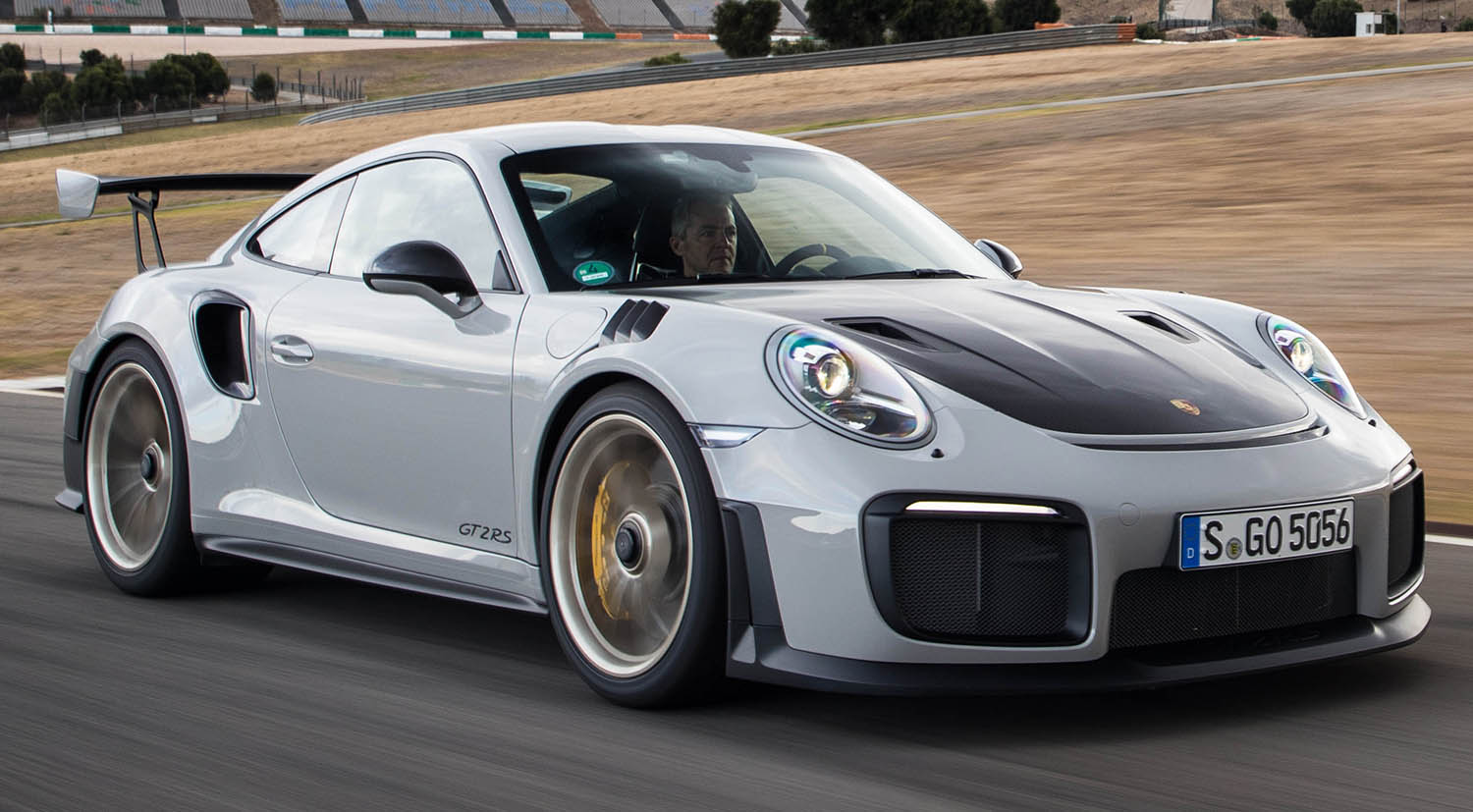
Best grip: Mixed tyres and ceramic brakes
Ultra High Performance tyres take on the job of transferring the longitudinal and lateral forces. As is often seen with high-performance sports cars from Porsche, the front and rear axles differ not only in terms of width, but also in size. The front axle is equipped with 9.5-inch-wide 265/35 ZR 20 tyres with a diameter of 20 inches. The 12.5 J x 21 alloy wheels at the back are equipped with 325/30 ZR 21-category tyres. The new forged alloy wheels with central locking are painted in Metallic White-Gold and bear the “GT2 RS” logo. The Tyre Pressure Monitoring (TPM) system is included as standard and not only issues a warning in the event of gradual or sudden pressure loss, it also has a race circuit mode, which takes into account the lower air pressure of cold tyres at the start of the track session.
Engine power of 515 kW (700 hp) and a racing chassis demand the best braking system that Porsche has ever developed. The Porsche 911 GT2 RS is equipped with the Porsche Ceramic Composite Brake (PCCB) system as standard. The perforated ceramic brake discs have a diameter of 410 millimetres at the front and 390 millimetres at the back. Yellow-painted six-piston fixed callipers made from aluminium monobloc at the front axle and four-piston aluminium-monobloc fixed callipers at the rear axle ensure a high and above all constant brake pressure when decelerating. The extremely light but exceptionally fading-resistant brake discs weigh only about half as much as conventional cast-iron discs. This not only has a noticeably positive effect on driving performance and fuel consumption, but also reduces the unsprung and rotary masses in particular. The result: improved road grip, better handling and enhanced driving and rolling comfort, particularly on uneven roads.
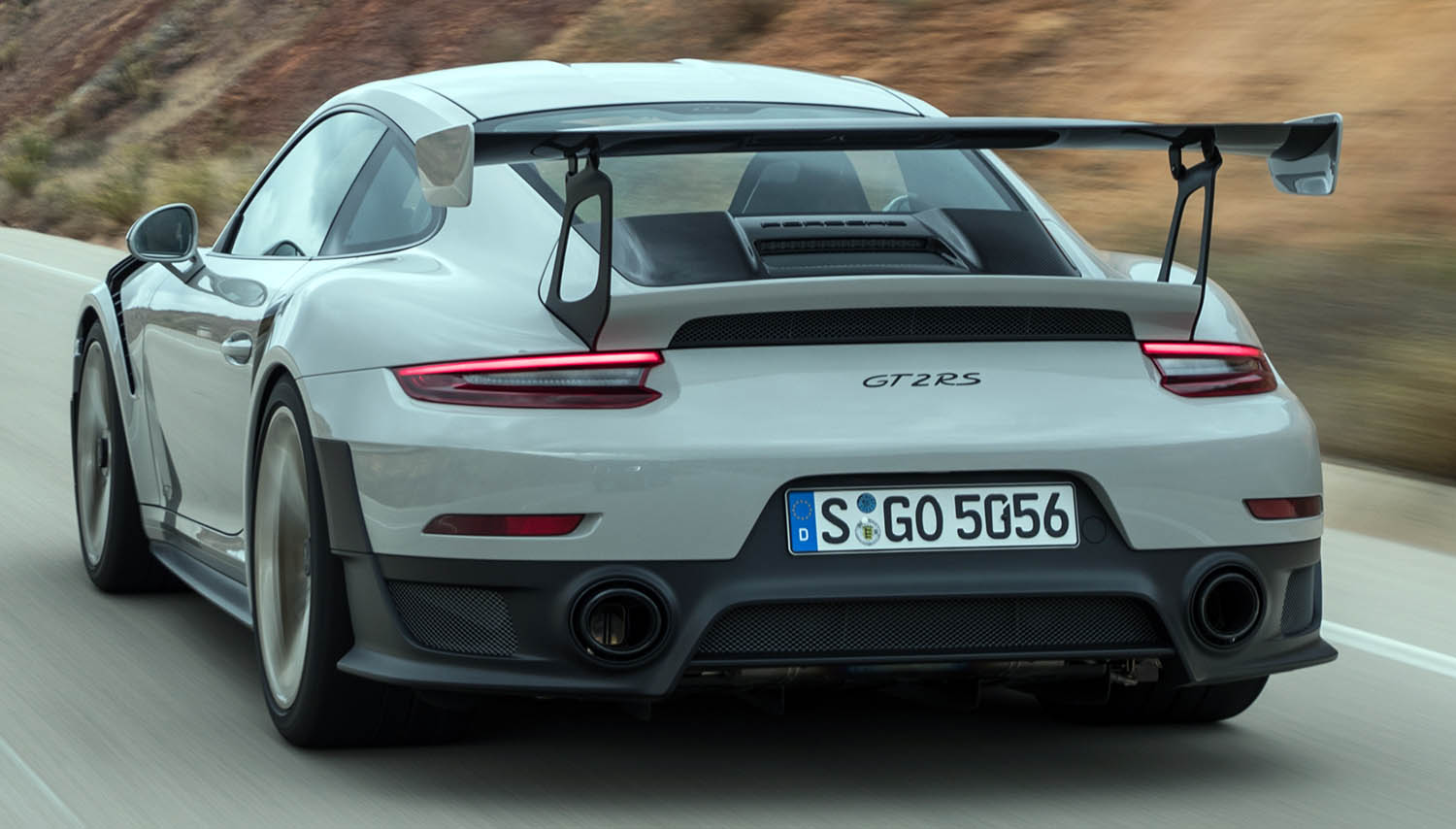
Active driving dynamics system on a par with the field of motorsport
The precision offered by the racing chassis provides the backbone for the driving dynamics systems fitted in the 911 GT2 RS. The PASM shock-absorber system and rear-axle steering are among the computer-controlled chassis functions on offer. The Porsche Stability Management (PSM) system and the fully variable PTV Plus differential lock optimise handling through the propulsion and brake forces. All systems communicate with one another and are optimally tuned to one another taking key racing considerations into account.
The Porsche Active Suspension Management (PASM) system adjusts the damper force at each individual wheel based on parameters developed specifically for the Porsche 911 GT2 RS. The driver can choose between two programs. Normal mode is designed for sporty driving on public roads and race tracks in the wet. Sport mode adjusts the damper forces for maximum lateral acceleration and the best possible traction on the race track.
Depending on the speed plus the driving and steering situation, the rear-axle steering system simultaneously increases stability or agility. The characteristics of these properties have also been tuned with sportiness in mind. At low speeds, the system steers the rear wheels in the opposite direction to the turned front wheels. Tight bends can be driven through more dynamically, increasing agility. In everyday situations, parking is made easier and the vehicle’s turning circle is reduced. At high speeds, the system moves the rear wheels in the same direction as the turned front wheels. This increases driving stability, which really pays off when changing lanes quickly or performing overtaking manoeuvres on the race track.
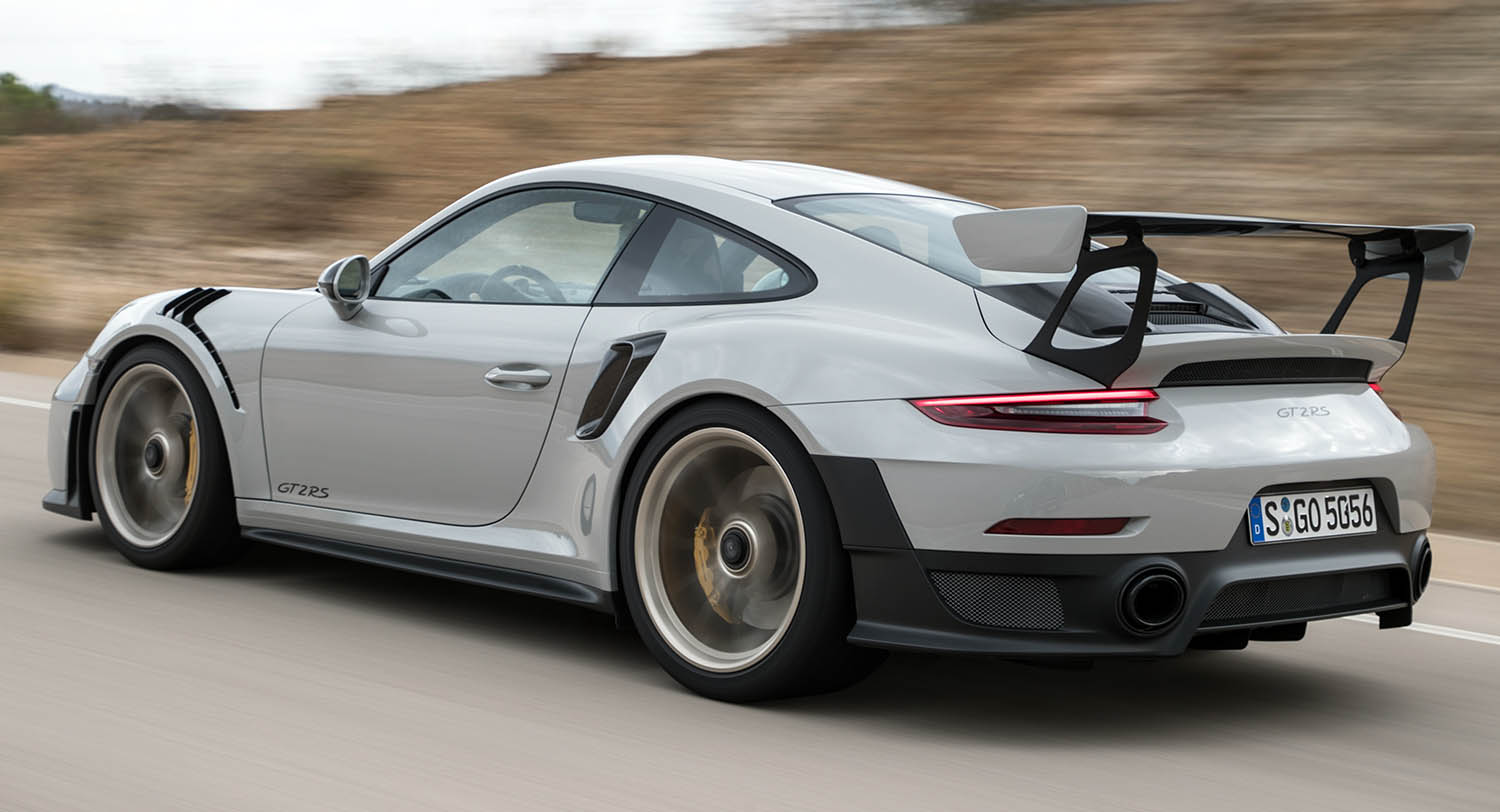
“PSM Sport” for the fastest lap times
The latest generation of PSM is ideally suited to the requirements of the 911 GT2 RS. The sensitive and precisely dosed control interventions can be completely deactivated in two stages. The first deactivation stage, “PSM Sport”, differs quite significantly in terms of function from the full system, “PSM On”. The “Sport” function enables significantly larger yaw movements around the vertical axis and a higher degree of slip on the drive wheels. In this way, “PSM Sport” allows more ambitious drivers to push the limits even further while offering the same emergency reserve as a vehicle with the stability control system switched on: Braking heavily in the ABS control range activates the stabilising support provided by the PSM in full again, as long as the brake pedal remains depressed.
The Porsche Torque Vectoring Plus (PTV Plus) is the ideal partner for PSM. The PTV Plus works with an electronically controlled, fully variable rear differential lock and takes all driving parameters that are relevant to lateral dynamics into account in its interventions. The result is greater traction, increased lateral dynamics and significantly increased stability during load changes in bends and during lane changes. What’s more, the system also makes targeted braking interventions on the inside rear wheel, giving the outside rear wheel increased drive torque. The system also improves steering behaviour and increases agility.
Road-approved but race track-ready
The fact that the design of the 911 GT2 RS is centred around the vehicle’s racing properties is unmistakable from every angle. Drag makes way for downforce, top speed makes way for cornering speed. The wide coupé nestles low to the road. The wide front spoiler lip only leaves the necessary gap for ground clearance, contributing the most to ensuring downforce at the front axle. The striking air intakes on the aerodynamic front end and behind the doors are indications of the huge demand for cooling air required by the powertrain, brakes and charge-air coolers at full power application. The additional air vent in front of the front lid – typical for 911s in the GT class – supports the flow of air through the central radiator and simultaneously increases the aerodynamic downforce at the front axle.
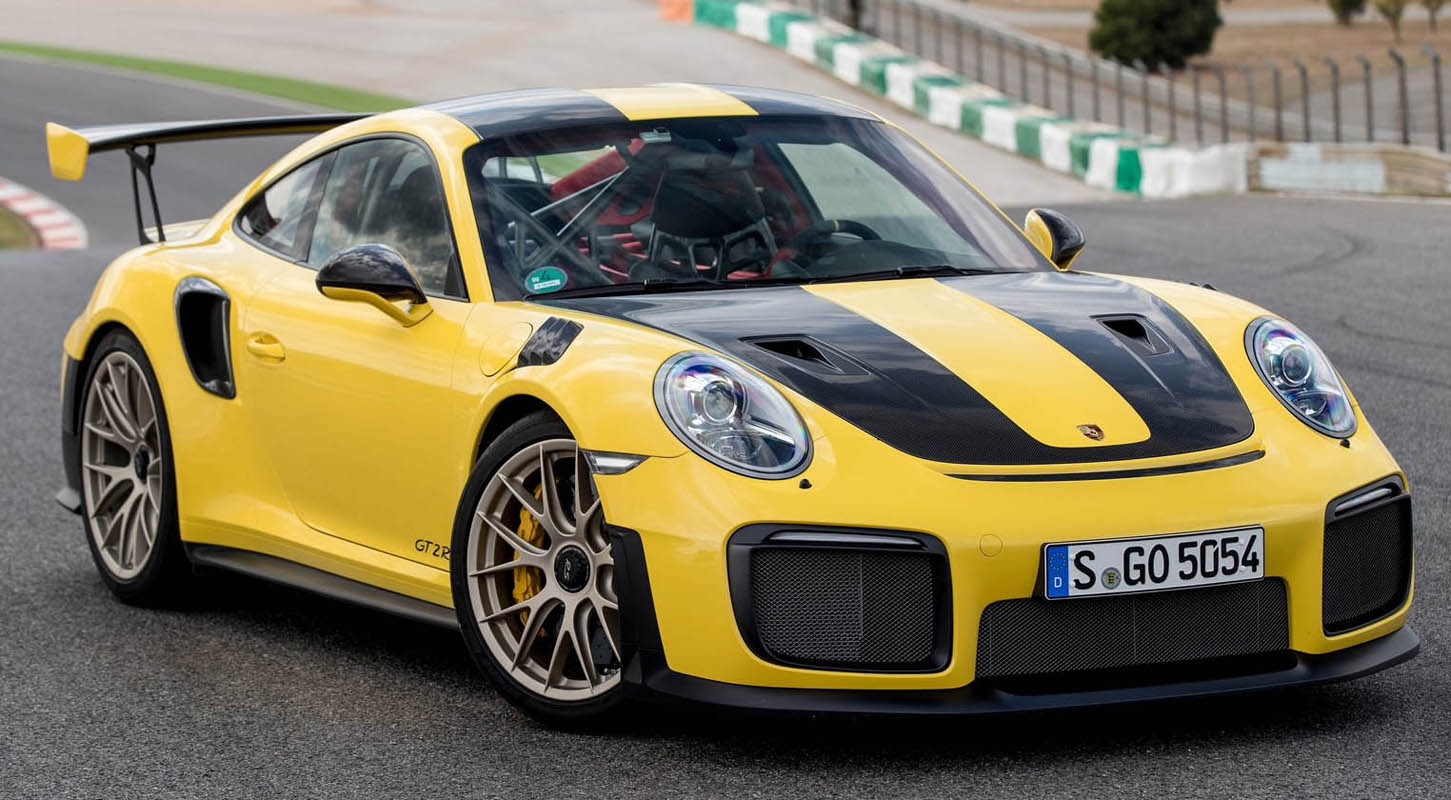
Two intakes in the bonnet improve ventilation of the brake system without negatively affecting the drag coefficient. Developed by the predecessor to NASA, these “NACAs” are being used in a series-produced Porsche vehicle to cool the brakes at this point for the very first time. Motorsport technology is also evident in the front wheel arch vents of the wings. Carbon slats ensure efficient ventilation of the front wheel arches. This reduces the overpressure generated by the turning wheels, and therefore also reduces lift.
The strikingly broad side skirts also contribute to the impressive appearance of the Porsche 911 GT2 RS and its sophisticated aerodynamics: The enlarged underbody surface creates a greater vacuum. Downforce increases to exceed speed. The main part of the aerodynamically generated wheel load on the rear axle is provided by the fixed rear wing in a carbon-weave finish. The wing supports are made of forged aluminium, while the new side plates are kept in the same colour as the vehicle exterior. At a speed of 340 km/h, a total of 340 kilograms of aerodynamic downforce is exerted on the coupé. When tuned for racing, the contact pressure increases to up to 450 kilograms. Two Ram Air Scoops on the rear lid – the dynamic pressure collectors – supply the engine with combustion air. Four fins on the rear end transform the bottom engine cowling into a diffusor, thereby improving the air supply.
Lightweight design: The right material in the right places
The second visible dominant theme of the 911 GT2 RS is lightweight construction. With the torso of the 911 Turbo in an aluminium-steel composite construction, the two-seater boasts a design that is both commendably lightweight yet rigid. The front lid, front wings, wheel arch vents, outer shells on the Sport Design exterior mirrors, air intakes on the rear side sections and parts of the rear end are made from carbon-fibre-reinforced plastic, as are many of the interior components. The bonnet is also made from carbon and the roof is finished with magnesium. Both body parts have a wide lateral swage line. This contour is not simply a visually distinctive feature for the lightweight components, but also increases the rigidity of the material.
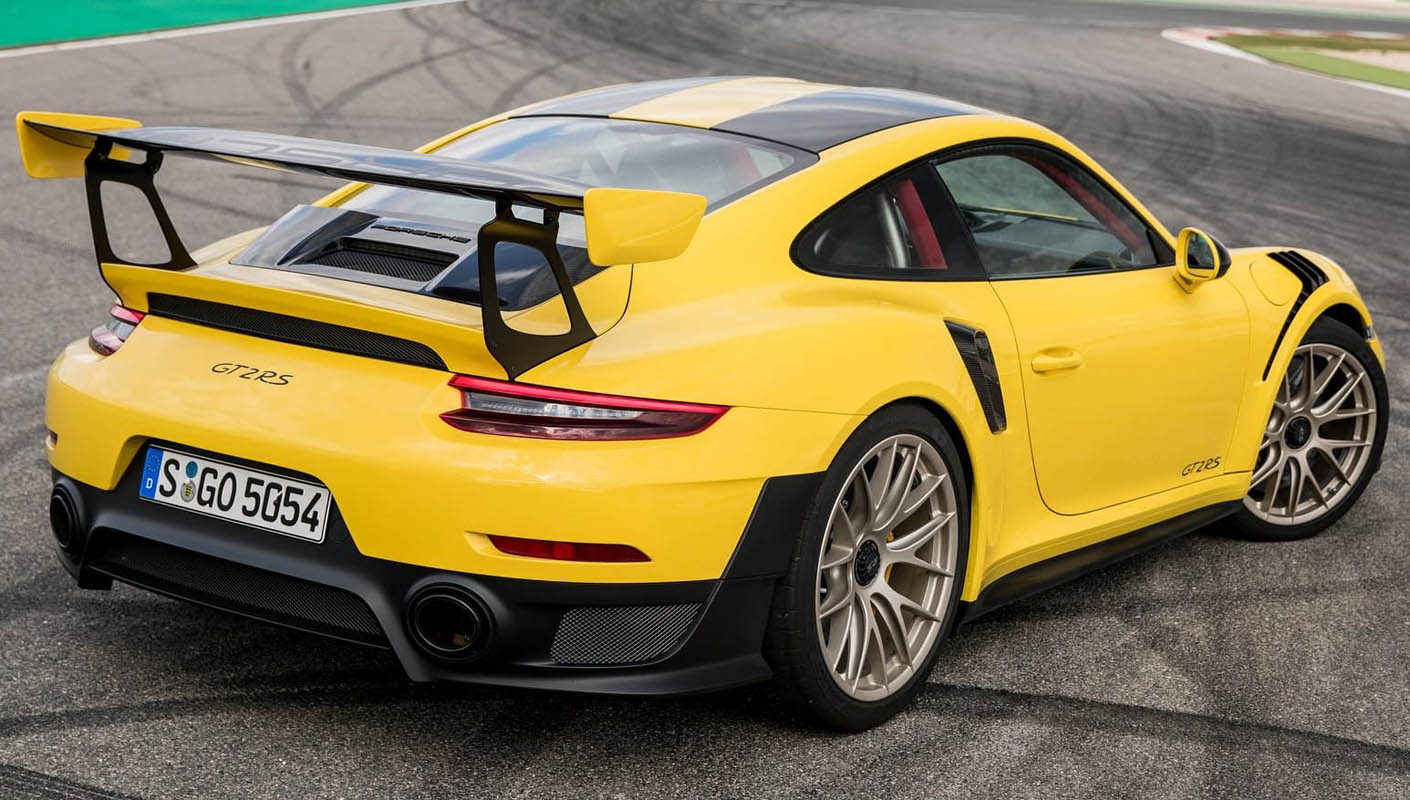
As a particularly lightweight and yet nevertheless extremely stable high-tech material, Porsche uses lightweight polyurethane with glass spheres and carbon fibre elements in the front and rear apron of the GT sports car. The rear window and rear side windows are made from lightweight glass – a real innovation at Porsche. The material is as light as polycarbonate, but also particularly resistant to scratching and breakages. Inside, the new 911 GT2 RS boasts lightweight door trims with opening loops. Drivers also have the option of dispensing with the sound system, air-conditioning system or Clubsport package to further improve the power-to-weight ratio.
Clubsport package as standard
The new Porsche 911 GT2 RS is supplied with the Clubsport package as standard. This package consists of a roll cage bolted to the body behind the front seats, a six-point seat belt in red for the driver’s side, a fire extinguisher complete with mounting bracket and a preparation for the battery main switch. The switch is available separately via the Porsche motorsport department, as is the front cage bracket for motorsport events.
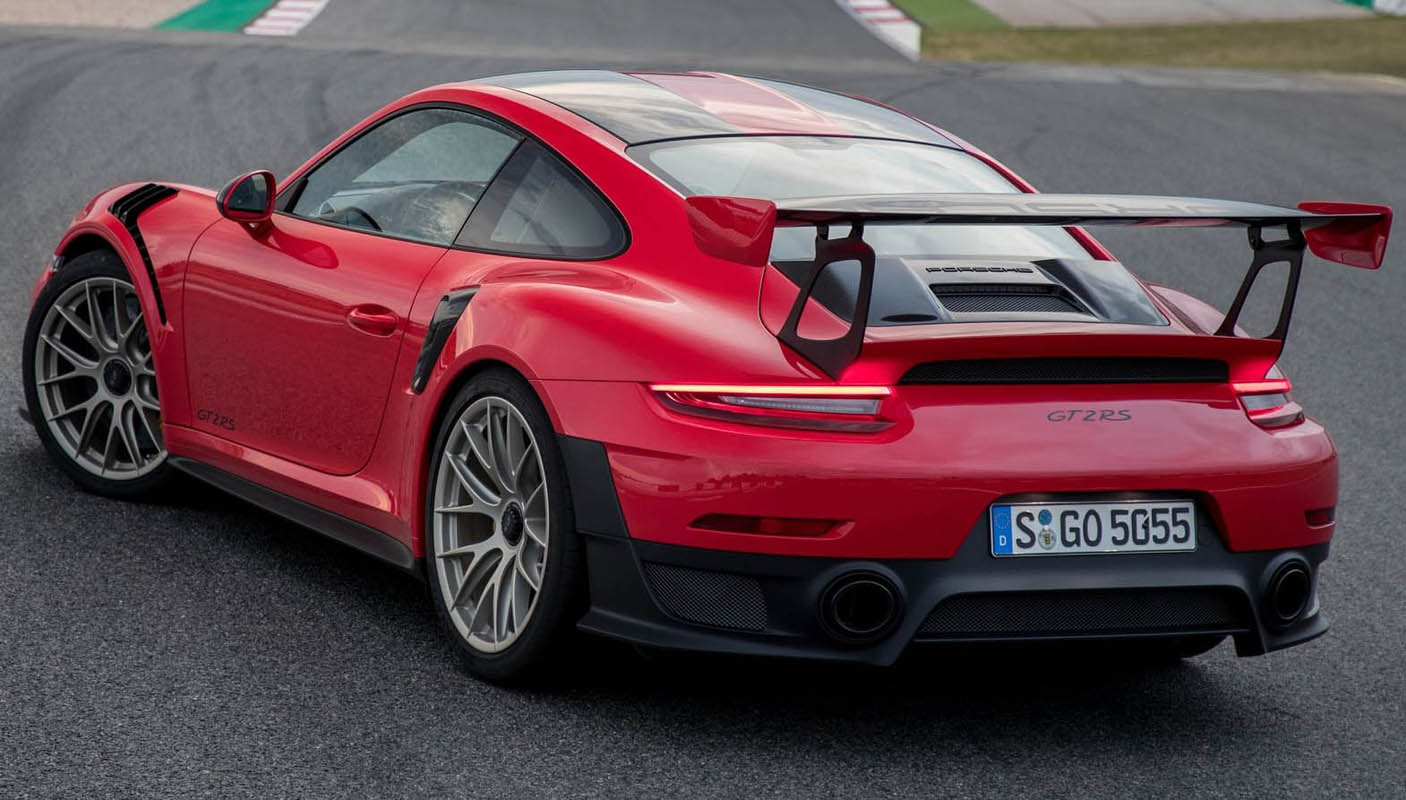
The school of lightweight construction: Weissach package for enhanced performance
Ever since the 918 Spyder, the Weissach package has been synonymous with increased performance through lightweight construction. The 911 GT2 RS is almost 30 kilograms lighter than that model thanks to its specially developed Weissach package. The roof and anti-roll bars on the front and rear axle are made of carbon. Even details such as the steering wheel trim and the gearshift paddles are made of the carbon material. The magnesium wheels alone, painted in satin-finish White-Gold, help the new 911 GT2 RS equipped with Weissach package shed over 11 kilograms in weight. The anti-roll bars and coupling rods save a further 5.3 kilograms in weight. This optimisation work also extends into the passenger compartment: The bolted roll cage is made of titanium and weighs around 9 kilograms less than the standard roll cage made of steel. The front lid and the carbon-weave-finish roof are emblazoned with a central strip in the same colour as the car for a visually distinctive look. The “Weissach package” logo can also be found on the headrests on the bucket seats and on a plaque on the cupholder trim.
Two-seater with an elegant, sporty vibe
The interior of the new Porsche 911 GT2 RS demonstrates clear sporty lines and the highest level of quality. The red Alcantara, black leather and multiple interior elements in a carbon-weave finish dominate. The GT2 RS sports steering wheel with gearshift paddles enables quick and sporty gear changes. Drivers and passengers experience the driving dynamics of the high-performance sports car in full bucket seats with a full carbon-weave finish. These seats offer particularly good lateral support with minimal weight. The fore/aft adjustment is done manually, while the adjustment mechanism is electrically operated. Porsche also offers the option of bucket seats with a folding backrest, built-in thorax airbag and manual fore/aft adjustment mechanism for the driver’s and passenger’s side. The seat shell is made of glass-and-carbon-fibre-reinforced plastic with a carbon-weave finish surface. Another option is the Sports seats Plus with electric 18-way adjustment. Like all GT sports cars from Porsche, the 911 GT2 RS is a two-seater model with a cover at the rear.
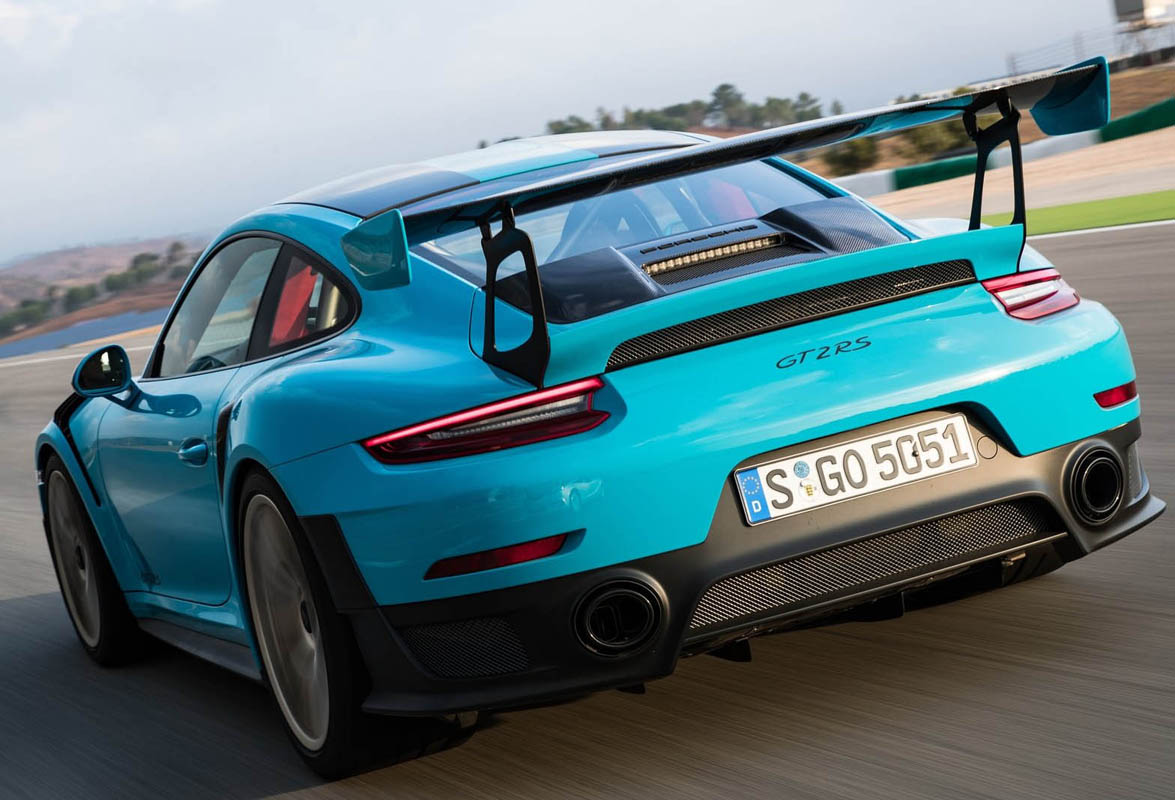
As in every 911, the Porsche Communication Management (PCM) is the central control unit for audio, navigation and communication. The current generation with mobile phone preparation, audio interfaces and voice control features a high-resolution seven-inch touch display, via which most functions can easily be controlled. As an audio system, the 911 GT2 RS is fitted as standard with the Sound Package Plus with eight loudspeakers and 150 Watts of power. The BOSE® Surround Sound System featuring twelve fully active loudspeakers and 100-Watt subwoofer in a solid shell construction is also available as an option. The Connect Plus module and Track Precision app also remain part of the standard equipment.
The “Porsche Track Precision” app allows the detailed recording, display and analysis of driving data on a smartphone. The app graphically displays the driving dynamics on the smartphone during race track use and, in addition to the sector and lap times, also shows deviations compared to a set reference lap time. Graphical analysis of the driving data and a video analysis help the driver to further improve driving performance.
Optional: Chrono Package for individual driver training
The optional Chrono Package expands the PCM functions to include performance display, which can be used to display, save and evaluate track times. The package also includes a stopwatch on the switch panel with both analogue and digital display. What’s more, the Chrono Package on the Porsche 911 GT2 RS comes with a lap trigger. Using the Porsche Track Precision app in conjunction with external markers at the start and finish, this lap trigger enables drivers to record lap times with a high level of precision.
